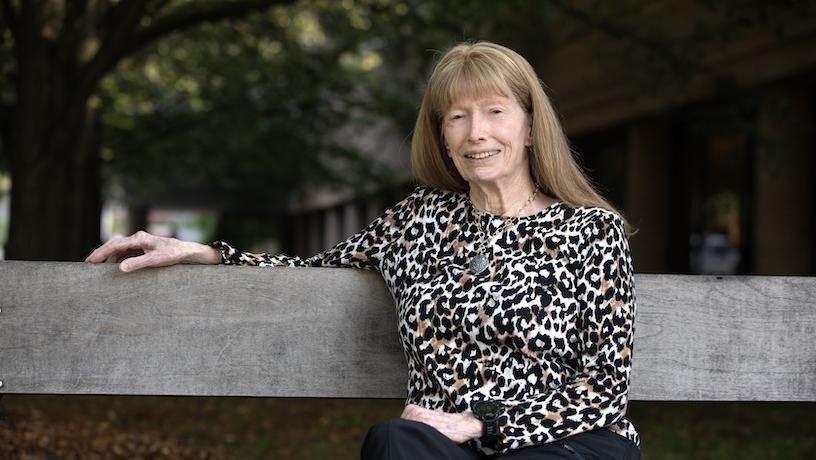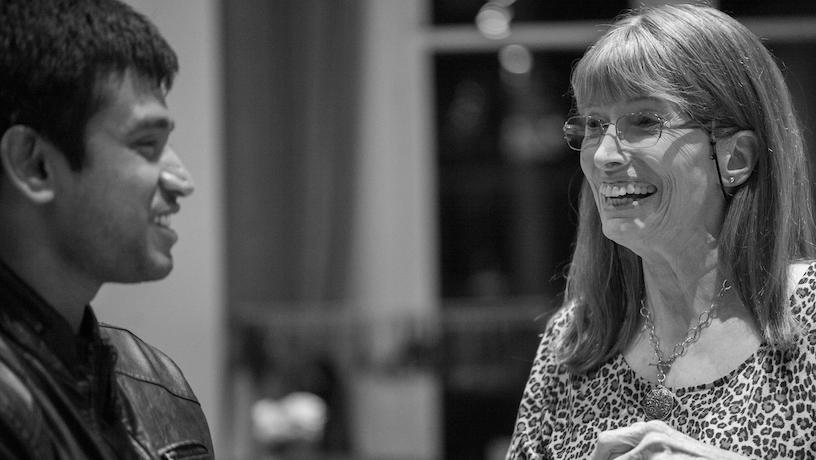Columbia Mourns the Loss of Tech Pioneer and Trans Rights Advocate Lynn Conway ’62, ’63
Once overlooked, Conway’s work laid the foundation for modern computing technologies.

Lynn Conway BS’62, MS’63, professor emerita of electrical engineering and computer science at the University of Michigan, Ann Arbor poses for a portrait at the University of Michigan’s North Campus. Conway is an American computer scientist, electrical engineer, and transgender activist.
Lynn Conway, a pioneer in the realms of computer science and engineering, and an advocate for transgender rights, passed away from a heart condition on June 9 at the age of 86. Throughout her career, Conway made groundbreaking contributions to computer architecture and microelectronics that opened the field to more researchers.
Conway was born on January 2, 1938, in Mount Vernon, NY. Her interest in physics brought her to study first at MIT and then to earn a bachelor’s and master’s in electrical engineering from Columbia Engineering in 1962 and 1963, respectively. While at Columbia, she conducted research under Herb Schorr, who recruited her to join IBM Research in Yorktown Heights, NY, following her studies.
At IBM, Conway would make a pivotal invention–dynamic instruction scheduling (DIS), a hardware method that enhances computer performance by reordering instructions based on readiness instead of in order. Despite the far-reaching influence of her early inventions, these achievements would become obscured due to another development in Conway’s life that led to a change in her identity. In 1968, she was fired from IBM because of her decision to undergo gender affirmation surgery. (IBM apologized in 2020 and issued Conway a Lifetime Achievement Award.) Ken Shepard, Lau Family Professor of Electrical Engineering and professor of biomedical engineering at Columbia, would later write in IEEE Solid States Circuits Magazine how Conway’s need to hide her identity allowed many to overlook her research contributions.
After her transition, Conway had to build a whole new life, starting out again as a contract programmer at Computer Associates, Inc. (CAI), then moving to Memorex Corp. to become a digital systems designer and computer architect. She then joined the famed research organization Xerox Palo Alto Research Center (PARC) in 1973. It was during this chapter of her career that Conway did pioneering work in very-large-scale integration (VLSI) chip design methods, an effort that started her collaboration with Carver Mead, a professor at Caltech who is credited with inventing the term “Moore’s Law.

Lynn Conway, pictured with an attendee after delivering the 2016 Magill Lecture at Columbia Engineering. Credit: Timothy Lee/Columbia Engineering
As advances in computing ramped up during the 1970s, smaller companies needed to learn to design chips in order to compete with the big semiconductor firms. Conway’s background experience at IBM had helped prepare her for such work and soon she developed a more efficient way to make microchips. She and Mead documented the process in a textbook, “Introduction to VLSI Systems.” Initially a self-published text for use at Xerox, it soon became a seminal work influencing scores of future programmers and researchers.
The book and its methods–which become known as the Mead-Conway method–also became a course on microchip design at MIT taught by Conway herself. The course was so successful it inspired similar courses across the country. Such courses prepared a new generation of tech workers and entrepreneurs who would build what would become Silicon Valley.
Her contributions with Mead also included the Metal Oxide Semiconductor Implementation Service (MOSIS) system, an internet-based infrastructure that enables rapid prototyping of chips. It was another development that allowed academia and small companies to access advanced technology.
Conway would leave Xerox to join DARPA in the early 1980s for the Defense Department’s Strategic Computing Initiative. Then in 1985, Conway joined the faculty of the University of Michigan and its burgeoning program in VLSI design. She retired in 1998 as professor emerita. On August 13, 2002, Conway married her longtime partner Charles “Charlie” Rogers, a professional engineer.
Outside of her contributions to science and technology, Conway became an outspoken advocate for transgender issues after going public with her own story post-retirement. Through her website, she documented her life journey and promoted awareness and acceptance, as well as medical resources and information on transgender issues. She also advocated for employment protections for transgender workers in tech and transgender inclusion in the IEEE's code of ethics.
Throughout her career, Conway garnered numerous awards and honors, including election to the National Academy of Engineering, the American Association for the Advancement of Science, and was named a fellow of the Institute of Electrical and Electronics Engineers (IEEE). She also received IEEE’s 2009 Computer Pioneer Award and the 2015 IEEE/RSE Maxwell Medal. She was awarded honorary degrees from Trinity College, Illinois Institute of Technology, University of Victoria, University of Michigan, Princeton University, and Syracuse University. For her advocacy, she was named one of the "21 Transgender People Who Influenced American Culture" by Time Magazine and one of the “Stonewall 20 trans heroes” by the International Court System and the National Gay and Lesbian Task Force.
In 2016, Conway was the guest speaker at Columbia Engineering’s annual Magill Lecture, where she shared how advances in technology throughout history had helped shepard in great social changes. Her own legacy had helped make technology more accessible and diffused ideas, which in turn, had advanced the state of the art. Speaking of our own time and current and emerging technologies, Conway hailed it as the “techno-social age,” a time when cooperation and sharing of ideas would be more important than ever.
While Conway cautioned that energy-use and overuse of the planet needed to be reigned in, she ultimately looked forward to humanity “opening-up unprecedented explorations of the greatest frontier . . . the frontier of what it’s possible to do.”
